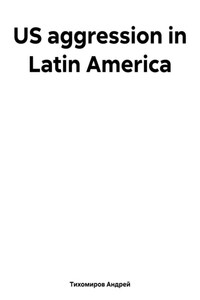US aggression in Latin America in the 19th century
Latin America is the collective name for American countries and territories that officially use the Romance languages: Spanish, Portuguese and French.
US aggression in Latin America began even before they gained state independence. During the War of Independence in Latin America, the United States captured part of the territories of the rebel Spanish colonies. Later they seized vast territories from Mexico. Soon after its publication in December 1823, the Monroe Doctrine became the main ideological weapon of American expansionists. Behind the words “America for Americans,” the words “America for the USA” sounded more and more clearly.
After the Civil War (1861-1865), having strengthened economically, the United States began to push back the British in the Caribbean. During the Pacific War 1879-1884. they attempted to gain a foothold further south. During the first period of the war, US diplomacy organized protests against the actions of the Chilean fleet off the coast of Peru. By doing this, she tried to ensure trade for the Americans in South America and provide moral support to Peru, as opposed to that provided by the British to Chile.
The defeat of the Peruvians at Tacna and Arica showed the clear superiority of Chile.
The United States understood well that Chile (and, consequently, England) could retain the entire area of nitrate development. On October 22, 1880, the American envoy to Peru, Christiansi, acted as a mediator. He gathered representatives of the warring states on an American warship, which was located near Arica. But the position taken by the envoy (he secretly pushed the allies to demand the return of all conquered territories by the Chileans) did not bring about reconciliation. When the question of concluding a peace treaty arose, the same Christiansi convinced the new Peruvian government of Garcia Calderon that the United States would not allow, even to the point of armed intervention, the dismemberment of Peru. This line is still
Christiansi's replacement, Hurlbut, was conducted more energetically.
Hurlbut's activities were fueled by the personal interest and interest of those American capitalists with whom he was associated. These capitalists, taking into account the impotence of Peru and Bolivia and their desire to find a protector in the United States, developed a plan to create the “Peruvian Company”. The Libyan and Peruvian saltpeter deposits and guano reserves in the territory of already occupied Chile were to pass into her hands. Secretary of State Blaine took part in the scam.










